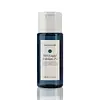What's inside
What's inside
 Key Ingredients
Key Ingredients

 Benefits
Benefits

 Concerns
Concerns

 Ingredients Side-by-side
Ingredients Side-by-side

Water
Skin ConditioningPropanediol
SolventDiheptyl Succinate
EmollientGlycerin
HumectantAmmonium Acryloyldimethyltaurate/Vp Copolymer
Salicylic Acid
MaskingPhenoxyethanol
PreservativeCaprylyl Glycol
EmollientTromethamine
BufferingEthylhexylglycerin
Skin ConditioningTriethyl Citrate
MaskingBenzoic Acid
MaskingAllantoin
Skin ConditioningCamellia Sinensis Seed Oil
HumectantBisabolol
MaskingPunica Granatum Seed Oil
EmollientVitis Vinifera Seed Oil
EmollientCentella Asiatica Extract
CleansingDiglucosyl Gallic Acid
T-Butyl Alcohol
Perfuming1,2-Hexanediol
Skin ConditioningCapryloyl Glycerin/Sebacic Acid Copolymer
Skin ConditioningGlycyrrhiza Glabra Root Extract
BleachingLilium Candidum Bulb Extract
Skin ConditioningCamellia Sinensis Leaf Extract
AntimicrobialWater, Propanediol, Diheptyl Succinate, Glycerin, Ammonium Acryloyldimethyltaurate/Vp Copolymer, Salicylic Acid, Phenoxyethanol, Caprylyl Glycol, Tromethamine, Ethylhexylglycerin, Triethyl Citrate, Benzoic Acid, Allantoin, Camellia Sinensis Seed Oil, Bisabolol, Punica Granatum Seed Oil, Vitis Vinifera Seed Oil, Centella Asiatica Extract, Diglucosyl Gallic Acid, T-Butyl Alcohol, 1,2-Hexanediol, Capryloyl Glycerin/Sebacic Acid Copolymer, Glycyrrhiza Glabra Root Extract, Lilium Candidum Bulb Extract, Camellia Sinensis Leaf Extract
Water
Skin ConditioningButylene Glycol
HumectantPropanediol
SolventSalicylic Acid
MaskingSodium Polyacrylate
AbsorbentCitric Acid
BufferingGlycerin
HumectantDiglycerin
HumectantCitrus Glauca Fruit Extract
HumectantMicrocitrus Australasica Fruit Extract
Microcitrus Australis Fruit Extract
Skin ConditioningHydroxyacetophenone
AntioxidantCarrageenan
Phenoxyethanol
PreservativeSodium Phytate
Caprylyl Glycol
EmollientPhenylpropanol
MaskingTocopherol
AntioxidantWater, Butylene Glycol, Propanediol, Salicylic Acid, Sodium Polyacrylate, Citric Acid, Glycerin, Diglycerin, Citrus Glauca Fruit Extract, Microcitrus Australasica Fruit Extract, Microcitrus Australis Fruit Extract, Hydroxyacetophenone, Carrageenan, Phenoxyethanol, Sodium Phytate, Caprylyl Glycol, Phenylpropanol, Tocopherol
 Reviews
Reviews

Ingredients Explained
These ingredients are found in both products.
Ingredients higher up in an ingredient list are typically present in a larger amount.
Caprylyl Glycol is a humectant and emollient, meaning it attracts and preserves moisture.
It is a common ingredient in many products, especially those designed to hydrate skin. The primary benefits are retaining moisture, skin softening, and promoting a healthy skin barrier.
Though Caprylyl Glycol is an alcohol derived from fatty acids, it is not the kind that can dry out skin.
This ingredient is also used as a preservative to extend the life of products. It has slight antimicrobial properties.
Learn more about Caprylyl GlycolGlycerin is already naturally found in your skin. It helps moisturize and protect your skin.
A study from 2016 found glycerin to be more effective as a humectant than AHAs and hyaluronic acid.
As a humectant, it helps the skin stay hydrated by pulling moisture to your skin. The low molecular weight of glycerin allows it to pull moisture into the deeper layers of your skin.
Hydrated skin improves your skin barrier; Your skin barrier helps protect against irritants and bacteria.
Glycerin has also been found to have antimicrobial and antiviral properties. Due to these properties, glycerin is often used in wound and burn treatments.
In cosmetics, glycerin is usually derived from plants such as soybean or palm. However, it can also be sourced from animals, such as tallow or animal fat.
This ingredient is organic, colorless, odorless, and non-toxic.
Glycerin is the name for this ingredient in American English. British English uses Glycerol/Glycerine.
Learn more about GlycerinPhenoxyethanol is a preservative that has germicide, antimicrobial, and aromatic properties. Studies show that phenoxyethanol can prevent microbial growth. By itself, it has a scent that is similar to that of a rose.
It's often used in formulations along with Caprylyl Glycol to preserve the shelf life of products.
Propanediol is an all-star ingredient. It softens, hydrates, and smooths the skin.
It’s often used to:
Propanediol is not likely to cause sensitivity and considered safe to use. It is derived from corn or petroleum with a clear color and no scent.
Learn more about PropanediolSalicylic Acid (also known as beta hydroxy acid or BHA) is a well-known ingredient for treating skin that struggles with acne and clogged pores. It exfoliates both the skin's surface and deep within the pores to help clear out buildup, control oil, and reduce inflammation.
Unlike AHAs (alpha hydroxy acids), salicylic acid is oil-soluble. This allows it to penetrate into pores which makes it especially effective for treating blackheads and preventing future breakouts.
Salicylic acid is also known for its soothing properties. It has a similar structure to aspirin and can calm inflamed or irritated skin, making it a good option for acne-prone skin that is also sensitive.
Concentrations of 0.5-2% are recognized by the U.S. FDA as an over-the-counter topical acne product.
It can cause irritation and/or dryness if one's skin already has a compromised moisture barrier, so it's best to focus on repairing that before introducing this ingredient into your routine.
While salicylic acid does not increase sun sensitivity, it’s still important to wear sunscreen daily to protect your skin.
If you are looking for the ingredient called BHA or Butylated Hydroxyanisole, click here.
Learn more about Salicylic AcidWater. It's the most common cosmetic ingredient of all. You'll usually see it at the top of ingredient lists, meaning that it makes up the largest part of the product.
So why is it so popular? Water most often acts as a solvent - this means that it helps dissolve other ingredients into the formulation.
You'll also recognize water as that liquid we all need to stay alive. If you see this, drink a glass of water. Stay hydrated!
Learn more about Water